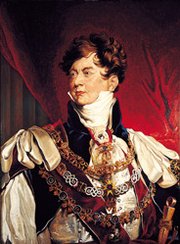Buckingham Palace
|
|
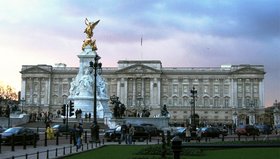
Buckingham Palace is the official London residence of the British monarch and the largest "working" royal palace remaining in the world. The expression "Buckingham Palace" or simply "The Palace" has become a common way of referring to the source of press statements coming from parts of the British Royal Family. In addition to being the London home of HM Queen Elizabeth II, Buckingham Palace is a setting for state occasions, royal entertaining and base for all officially visiting heads of state, and is a major tourist attraction. It has been a rallying point for the British at times of national rejoicing and crisis. However, it is not universally admired, and was voted the fourth ugliest building in London in March 2005.
The palace originally known as Buckingham House, a large townhouse built for the Duke of Buckingham in 1703, was acquired by King George III in 1762 as a private residence. It was enlarged over the next 75 years, principally by architects John Nash and Edward Blore, forming three wings around a central courtyard. Buckingham Palace finally became the official royal palace of the British monarch on the accession of Queen Victoria in 1837. The last major structural additions were made in Victoria's time, with the addition of the large wing facing east towards The Mall, and the removal of the former state entrance, Marble Arch, to its present position near Speakers' Corner in Hyde Park. The east front was refaced in Portland stone in 1913 as a backdrop to the Victoria Memorial, creating the present-day 'public face' of Buckingham Palace, including the famous balcony.
The original Georgian interior designs included widespread use of brightly coloured scagliola and blue and pink lapis, on the advice of Sir Charles Long. King Edward VII oversaw a heavy redecoration in a Belle epoque cream and gold colour scheme. Many smaller reception rooms are furnished in the Chinese regency style with furniture and fittings brought from the Royal Pavilion at Brighton and from Carlton House following the death of George IV. The Buckingham Palace Gardens are the largest private gardens in London, originally landscaped by Capability Brown, but redesigned by William Townsend Ailton of Kew Gardens and John Nash. The great man-made lake was completed in 1828 and is supplied with water from the Serpentine lake in Hyde Park.
| Contents |
History
Early history
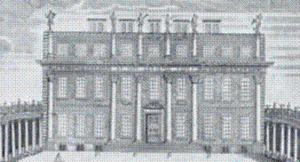
The first house recorded on the site of the present palace was known as Goring House, built by the Lord Goring circa 1633. However, the house which forms the nucleus of the present palace was built for the Duke of Buckingham and Normanby in 1703. Buckingham had the house rebuilt by the architect William Winde. The style chosen was of a large three floored central block with two smaller flanking service wings.
Buckingham's house was eventually sold by his descendant, Sir Charles Sheffield, in 1762 to King George III. The house was originally intended as a private retreat for the Royal Family, and in particular Queen Charlotte, George III's consort, rather than as an official royal palace. The official and ceremonial royal residence remained at St. James's Palace; indeed, today foreign ambassadors are still accredited to the Court of St. James's, even though it is at Buckingham Palace they present their credentials and staff to the Queen on their appointment.
House to palace
Queen Charlotte died in 1818 and her mentally unstable husband George III in 1820. Immediately, their son, the spendthrift George IV, decided to enlarge Buckingham House to use in conjunction with St. James's Palace as had his father, but by 1826 he had decided to convert the house to a fully-equipped official royal palace. He commissioned John Nash to create this vision. The palace which arose surrounded three sides of a large quadrangle, with the former Buckingham House at its centre. The new work was faced in Bath stone, with exquisite detailing in the French neoclassical style. This is the palace much as it is today, but without the great east front, facing The Mall, which now encloses the quadrangle. On the future site of the present east front, between the two projecting wings, was a colossal triumphal arch of Racaccione marble, modelled on the Arch of Constantine in Rome. This arch, which had cost £34,450 to erect, served as the state entrance. George IV had intended it to be crowned by a bronze equestrian statue of himself, but he died before its completion, and when Parliament reluctantly paid the bill for it, they decided to erect it in Trafalgar Square. The interiors of the palace were to be of unparalleled splendour. George IV was advised on the interior design by Sir Charles Long, who advocated the widespread use of brightly coloured scagliola and blue and pink lapis, with sculptured plaster panels set in the ceilings. George IV died in 1830, and the colourful and heavily gilded present state and semi-state rooms were not completed until the reign of William IV, a man of simpler tastes, and his wife, Queen Adelaide.
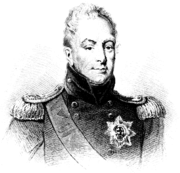
By the time of the death of George IV, the escalating cost of the still unfinished palace was causing concern in both Parliament and the press. William IV dismissed Nash as architect and employed Edward Blore, who suited admirably the more restrained tastes of the new king. A less idealistic but more businesslike architect than Nash, he retained Nash's completed work and completed the palace in a similar, if more solid and less picturesque, vein. Though the new King and Queen held receptions and courts in the state rooms they never lived in the palace, preferring to remain at Clarence House, the more modest London mansion they had commisioned to be built before their succession. The final cost to the nation of rebuilding Buckingham Palace was in excess of £719,000. It is interesting to note that when the Houses of Parliament burnt down in 1834, the King offered the incomplete palace to the nation as a replacement seat of government, an offer which suggests the new King was rather less taken with the ornate palace than his late brother. The offer was declined, however, and the old Palace of Westminster rebuilt.
Many of the smaller reception rooms were furnished at this time, as they still are, in the Chinese regency style, as many of the fireplaces, decorations, and furniture were brought from the Royal Pavilion at Brighton and from Carlton House, the palaces of George IV, following his death.
Queen Victoria
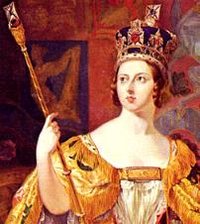
Buckingham Palace finally became the principal Royal residence in 1837 on the accession of Queen Victoria. While the state rooms were a riot of gilt and colour, the necessities of the new palace were somewhat less luxurious. It was reported the chimneys smoked so much that the fires had to be allowed to die, and consequently the court shivered in icy magnificence. Ventilation was so bad that the interior smelled, and when a decision was taken to install gas lamps there was a serious worry about the build up of gas on the lower floors. It was also said that the staff were lax and lazy and the palace was dirty. Following the Queen's marriage to Prince Albert in 1838, her husband concerned himself with a reorganization of the household offices and staff, and the design faults of the palace. The problems were attended to and the builders finally left the palace in 1840.
The large wing facing east towards The Mall (today the 'public face' of Buckingham Palace) was constructed after the marriage of Queen Victoria. By 1847, the couple had found the palace too small for court life and their growing family, and as a result the new wing, designed by William IV's architect Edward Blore, was built, enclosing the quadrangle which is the centre of the palace. This new wing contains the balcony from which the Royal Family acknowledge the crowds on momentous occasions. The ballroom wing and a further suite of state rooms were also built in this period, designed by Nash's student Sir James Pennethorne.
Before the death of Prince Albert, Queen Victoria was known to love music and dancing, and the great musicians of the day were commanded to play at Buckingham Palace. Felix Mendelssohn is known to have played there on three occasions. Johann Strauss II and his orchestra played there when in England. Strauss' 'Alice Polka' was first performed at the palace in 1849 in honour of the Queen's daughter Princess Alice. During this era Buckingham Palace was frequently the scene of lavish costume balls, in addition to the routine royal ceremonies, investitures and presentations.
Queen Victoria had Marble Arch, the former state entrance to the palace, moved to its present position near Speakers' Corner in Hyde Park. Following the death of Prince Albert in 1862, the Queen withdrew from public life and left Buckingham Palace to live at Windsor Castle, Balmoral Castle, and Osborne House. For many years the palace was seldom used, and even neglected. Eventually mounting negative public opinion forced the widowed queen to return to London, though even then she preferred to live elsewhere whenever possible. Court functions continued to be held at Windsor Castle rather than at the palace, presided over by the sombre Queen habitually dressed in mourning black.
The 20th century
Buckingham_palace_1909.jpg
In 1901 the accession of Edward VII saw new life breathed into the palace. The new King and his wife Queen Alexandra had always been at the forefront of London high society, and their friends, known as the Marlborough House set, were considered to be the most eminent and fashionable of the age. Buckingham Palace—the Ballroom, Grand Entrance, Marble Hall, Grand Staircase, vestibules and galleries redecorated in the Belle epoque cream and gold colour scheme they retain today—once again became the focal point of the British Empire and a setting for entertaining on a majestic scale. Many people feel King Edward's heavy redecoration of the palace does not complement Nash's original work. The present palace guide book asserts that the decorations, including plaster swags and other decorative motifs, are "finicky" and "at odds with Nash's original detailing". Even so, they have been allowed to remain for one hundred years.
1910_Buckingham_Palace.gif
The last major building work took place during the reign of King George V when, in 1913, Sir Aston Webb redesigned the famous east, principal, 1850 facade by Blore to resemble in part Giacomo Leoni's Lyme Park in Cheshire. This new refaced principal facade (of Portland stone) was designed to be the backdrop to the Victoria Memorial, a large memorial statue of Queen Victoria, placed outside the main gates. George V, who had succeeded Edward VII in 1911, had a more serious personality than his father, which was reflected in life at the palace: greater emphasis was now placed on official entertaining and royal duties than on lavish parties and having fun. George V's wife Queen Mary was a connoisseur of the arts, and took a keen interest in the Royal collection of furniture and art, both restoring and adding to it. Queen Mary also had many new fixtures and fittings installed, such as the pair of marble Empire style chimneypieces by Benjamin Vulliamy, dating from 1810, which the Queen had installed in the ground floor Bow Room, the huge low room at the centre of the garden facade. Queen Mary was also responsible for the decoration of the Blue Drawing Room. This room, 21 metres long, previously known as the South Drawing Room, has one of Nash's finest ceilings, coffered with huge gilt console brackets, and is referred to by the author and historian Olwen Hedley in his book Buckingham Palace as the most beautiful in the palace, grander and more lavish than either the Throne Room or the Ball Room, which was built to take over the Blue Drawing Room's original function.
Following the last major extension in 1850, the palace consisted (as it does today) of 19 state rooms, 52 principal bedrooms, 188 staff bedrooms, 92 offices, and 78 bathrooms. While this may seem large, it is small compared with the Tsar's palaces in St. Petersburg and at Tsarskoe Selo, the Papal Palace in Rome, or indeed the former Palace of Whitehall. A minor extension was made in 1938, in which the north-west pavillion, designed by Nash, was converted into a swimming pool.
World War
During World War I the palace, then the home of King George V and Queen Mary, escaped unscathed. Its more valuable contents were evacuated to Windsor but the Royal family remained in situ. The largest change to court life at this time was that the Government persuaded the King to ostentatiously and publicly lock the wine cellars and refrain from alcohol for the duration of the war, to set a good example to the supposedly inebriated lower classes. The lower classes continued to imbibe and the King was left reputedly furious at his enforced abstinence. Edward VIII later told a biographer that his father had a furtive glass of port each evening, while the Queen secretly laced her fruit cup with champagne. The King's children were photographed at this time serving tea to wounded officers in the adjacent Royal Mews.
During World War II The Palace fared worse: it was bombed no less than seven times, and was a deliberate target, as it was thought by the Nazis that the destruction of Buckingham Palace would demoralise the nation. One bomb fell in the palace quadrangle while King George VI and Queen Elizabeth were in residence, but while all the windows were blown in no serious damage was reported. However, war time coverage of such incidents was severely restricted. The most serious and publicised bombing was the destruction of the Palace chapel in 1940: coverage of this event was played in cinemas all over England to show the common suffering of rich and poor. The King and Queen were filmed inspecting their bombed home, the smiling Queen immaculate in a hat and matching coat. It was at this time the Queen made her famous quote: "I'm glad we have been bombed. Now I can look the East End in the face". It has only recently been reported that on some trips, prior to this event, to inspect the London bomb damage, the Royal family were booed rather than cheered as was reported at the time, hence the bombing of the palace was a propaganda coup for the British establishment As The Sunday Graphic dutifully reported:-
British_VE_Day.jpg
- By the Editor: The King and Queen have endured the ordeal which has come to their subjects. For the second time a German bomber has tried to bring death and destruction to the home of Their Majesties……..When this war is over the common danger which King George and Queen Elizabeth have shared with their people will be a cherished memory and an inspiration through the years".
Eleanor Roosevelt was accorded the status of visiting head of state during her World War II visit. The British war time press, anxious to show the monarchs sharing the hardships of their subjects, announced that as the contents of the palace had been evacuated to the country for the duration of the war, as an honoured guest Mrs. Roosevelt was "billeted" in the only comfortable room remaining, Queen Elizabeth's own bedroom. However, as it is now known that for the duration of World War II the Royal Family slept, for safety, every night at Windsor Castle, returning to use the palace during the day, it is probable this story is apocryphal. It is unlikely they would have left Mrs. Roosevelt in the empty palace to face the nightly blitz alone.
On VE Day (May 8, 1945), the Palace was the centre of British celebrations, with the King, Queen and the Princess Elizabeth, the future Queen, and Princess Margaret appearing on the balcony, with the palace's blacked out windows behind them, to the cheers from a vast crowd in the Mall.
Interior
Buckthroneroom.jpg
The principal rooms of the palace are contained on the piano nobile behind the west-facing garden facade at the rear of the palace. The centre of this ornate suite of state rooms is the Music Room, its large bow the dominant feature of the facade. Flanking the Music Room are the Blue and the White Drawing rooms. At the centre of the suite, serving as a corridor to link the state rooms, is the immense Picture Gallery, which is top lit and 55 yards (50m) long. The Gallery is hung with works by Rembrandt, van Dyck, Rubens, and Vermeer, among many others. Other rooms leading from the picture gallery are the Throne Room and the Green Drawing Room. The Green Drawing room serves as a huge anteroom to the Throne Room, and is part of the ceremonial route to the throne from the guard room at the top of the grand staircase. These rooms are used only for ceremonial and official entertaining.
Directly underneath the state apartments is a suite of slightly less grand rooms known as the semi-state apartments. Opening from the marble hall, these rooms, some, such as the '1844 Room', of which were decorated in that year for the State visit of Emperor Nicholas I of Russia, are used for less-formal entertaining such as luncheon parties and private audiences. At the centre of this suite is the Bow Room, through which thousands of guests pass annually to the Queen's garden parties in the gardens beyond. The Queen uses privately a smaller suite of rooms in the north wing.
Plan_of_Buckingham_palace.gif
Between 1847 and 1850, when Blore was building the new east wing, the Brighton Pavilion was once again plundered of its fittings. As a result many of the rooms in the new wing have a distinctly oriental atmosphere. The red and blue Chinese Luncheon Room is made up from parts of the Brighton banqueting and music rooms, but has a chimney-piece, also from Brighton, in design more Indian than Chinese. The Yellow Drawing Room has 18th century wall paper, which was supplied in 1817 for the Brighton Saloon, and the chimney-piece in this room is a European vision of what the Chinese equivalent would look like, complete with nodding mandarins in niches and fearsome winged dragons. At the centre of this wing is the famous balcony, with behind its glass doors the Centre Room. This is a Chinese style saloon enhanced by Queen Mary in the late 1920s, although the lacquer doors were brought from Brighton in 1873. Running the length of the piano nobile of the east wing is an immense gallery, modestly known as the Principal Corridor. It has mirrored doors, and mirrored cross walls reflecting porcelain pagodas and other oriental furniture from Brighton. The Chinese Luncheon Room and Yellow Drawing Room are situated at each end of this gallery, with the Centre Room obviously placed in the centre.
Visiting heads of state today, when staying at the palace, occupy a suite of rooms known as the Belgian suite, which is on the ground floor of the south-facing garden front. These rooms, with corridors enhanced by saucer domes, were first decorated for Prince Albert's uncle Leopold, the first King of the Belgians. King Edward VIII lived in these rooms during his short reign. Most presidents of the United States have occupied this suite at one time or another.
Interestingly, some of the esteemed guests occupying this suite are reported to be less than welcome for return visits. The entourage of one Sheikh is said to have barbecued a pig in the suite, while during the state visit of Nicolae Ceausescu, following a telephoned warning from the wife of the President of France, his immediate previous host, to the Queen small valuable works of art were temporarily removed from the suite in order to prevent them disappearing. These stories, though widely reported, have never been confirmed by Buckingham Palace.
Court ceremonies
During the current reign court ceremony has undergone a radical change, and entry to the palace is no longer the prerogative of just the upper class. Formal court dress has now been abolished, in previous reigns men not wearing uniform wore knee breeches of an 18th century design. Ramsay MacDonald in 1924, the Labour Prime Minister, was the first man to be received by a monarch inside the palace wearing a lounge suit, however, this was a one off concession. In the evenings women wore dresses with obligatory trains, and tiaras or feathers often both in their hair. So rigid was the palace dress code that after World War I when Queen Mary wished to follow fashion by raising her skirts a few inches from the ground, she asked a Lady-in-Waiting to shorten her skirt first to gauge the King's (her husband's) reaction. King George V was horrified and Queen Mary's hemline remained unfashionably low. While King George VI and Queen Elizabeth were slightly more fashionable, and daytime skirts were allowed to rise, prescribed evening court dress remained obligatory until World War II. Today, most men invited to Buckingham Palace in the day-time choose to wear service uniform or morning coats, and in the evening, depending on the formality of the occasion, black tie or white tie. If the occasion is 'white tie' then women, if they possess one, wear a tiara, although no dress code is officially demanded.
One of the first major changes was in 1958 when the Queen abolished the presentation parties for debutantes. These court presentations of aristocratic girls to the monarch took place in the Throne Room, where debutantes, in full court dress, with three tall ostrich feathers held precariously in their hair, entered the palace Throne Room, curtsied and then performed a choreographed backwards walk and a further curtsey, simultaneously skilfully, and often perilously, manoeuvring a dress train of a prescribed length. The Queen felt this ceremony, which corresponded to the "Drawing Rooms" of earlier reigns, to be elitist and antiquated, and replaced the presentations with large and frequent palace garden parties, to which a more varied cross section of British society is invited. The late Princess Margaret is reputed to have said of the debutante presentations: (1) "We had to put a stop to it, every tart in London was getting in." The Throne Room today is used for the reception of formal addresses such as that given to the Queen on her jubilees. It is here on the throne dais that royal wedding photographs are taken.
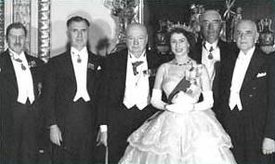
Investitures, which include the conferring of knighthoods by dubbing with a sword, and other awards take place in the palace's Victorian Ball Room, built in 1854. At 37 m by 20 m (123 ft by 60 ft), this is the largest room in the palace. It has replaced the Throne Room in importance and use. During investitures the Queen does not sit on the throne, but stands on the throne dais beneath a giant domed velvet canopy, known as a shamiana, used at the coronation Durbar in Delhi in 1911. A military band plays in the musicians' gallery, as the recipients of awards approach the Queen and receive their honours, watched by their families and friends. The Beatles were among the first non-establishment artists to be awarded honours at the palace. They later confessed to smoking cannabis in the palace lavatories with their luxurious fittings.
State banquets also take place in the ballroom. These formal dinners take place on the first evening of a state visit by a visiting Head of State. On these occasions, often over 150 guests in formal "white tie and decorations" and many women wearing tiaras dine off gold plate. The largest and most formal reception at Buckingham Palace takes place every November, when the Queen entertains members of the foreign diplomatic corps resident in London. On this occasion all the state rooms are in use, as the entire Royal Family process through them, beginning their procession through the great north doors of the Picture Gallery. As Nash had envisaged, all the huge double mirrored doors stand open, reflecting the numerous crystal chandeliers and sconces causing a deliberate optical illusion of space and light.
Smaller ceremonies such as the reception of new ambassadors take place in the '1844 Room'. Here too the Queen holds small lunch parties, and often meetings of the Privy council. Larger lunch parties often take place in the curved and domed Music Room, or the State Dining Room. On all formal occasions the ceremonies are attended by the Yeomen of the Guard in their anachronistic uniforms, and other officers of the court such as the Lord Chamberlain.
Since the bombing of the palace chapel in World War II, royal christenings have sometimes taken place in the Music Room. The Queen's first three children were all baptised here, in a special gold font. Prince William was christened in the Music room, However his brother, Prince Harry, was christened at St. George's Chapel Windsor.
However, it is the garden parties, when up to 9000 people attend, taking tea and sandwiches in a series of marquees, that are the largest functions of the year. The guests first assemble, then as a military band plays the National Anthem, the Queen emerges from the Bow Room, and slowly walks through the guests, greeting those previously selected for the honour, to her own more private tea tent. If the guests at these functions do not actually have the opportunity to meet the Queen, they at least have the consolation of being able to admire the manicured gardens.
Security
Royal security is supposedly high, but is more well known for a series of high-profile intrusions, both at the Palace and elsewhere. The famous armed sentries on guard at the front of the palace are thought to be ceremonial, but the palace contains its own police station, and the Royal Family have their own protection officers at all times. Other security measures are not revealed. The most notorious incident was when Michael Fagan gained access to the Queen's bedroom while she was asleep in 1982. In 2003 a reporter for the Daily Mirror, Ryan Parry spent two months working as a footman inside Buckingham Palace. One of the references he supplied was fake, and it appears this was not checked properly. The incident coincided with a visit to the UK by George W. Bush, who stayed at the Palace, and photographs of Bush's bedroom, along with the Queen's breakfast table and the Duke of York's room. In themselves the photographs revealed nothing more interesting than that the Queen's two younger sons had a conventional, almost bourgeois, taste in bedroom furnishings, and that the Queen kept her breakfast muesli in a tupperware container. The Palace took the Mirror to court for invasion of privacy, and the newspaper handed over its materials, and paid some of the Queen's costs in an out-of-court settlement in November 2003.
Most lapses of security have been outside the palace: In 1974, Ian Ball attempted to kidnap the Princess Royal at gunpoint in the Mall while she was returning to the palace, wounding several people in the process. Most notably, in 1994, a naked paraglider landed on the roof of the building. In 1995 a student, John Gillard, was able to deliberately ram the gates of the palace, knocking one of the great wrought iron gates weighing 1.5 tonnes off its hinges. Most recently, in 2004, Jason Hatch, a protester advocating the legal rights of single fathers received wide press coverage when he managed to climb onto a ledge near the ceremonial balcony on the east front dressed as Batman [1] (http://news.bbc.co.uk/1/hi/uk/3652502.stm). In the same incident, a second protester, Dave Pyke, dressed as Robin was apprehended before he managed to climb onto the building; he returned the following November dressed as Father Christmas to chain himself to a lamp on one of the main gateposts [2] (http://news.bbc.co.uk/1/hi/uk/4035987.stm).
Historically, there have been other lapses too numerous to catalogue. Probably the most incredible but true was in 1837, when a 12-year-old boy known to history as The boy Cotton managed to live for a year undetected inside the palace. Hiding in chimneys and blackening the beds he slept in, he was finally apprehended in December 1838, causing questions on royal security to be asked in Parliament. In 1950 a romanticised film, "The Mudlark", was loosely based on his story. Of the eight assassination attempts made on Queen Victoria, at least three occurred in the vicinity of the palace gates. In the early 20th century the front of the palace became a favoured venue for suffragettes, who would chain themselves to the gilded iron railings. Over the years numerous intruders have been apprehended in the palace grounds, including one who wished to propose marriage to Princess Anne, and who was declared insane. However, as the Queen is officially a non-political figure, demonstrations and protests tend to rally at the Palace of Westminster or Trafalgar Square rather than Buckingham Palace.
Use and public access

In addition to being the weekday home of the Queen and the Duke of Edinburgh the palace is the work place of 450 people. Every year some 50,000 people are entertained at garden parties, receptions, audiences, and banquets. Buckingham Palace is also the venue for the daily ceremony of the Changing of the Guard, a major tourist attraction. In June 2003 on the occasion of the Queen's golden jubilee thousands of Britons were invited to apply for tickets to a pop concert, preceded the previous evening by a classical concert in the grounds of the palace. These concerts, where the guests were given champagne and a picnic, were the first occasions when ordinary subjects and members of the public had been invited onto the premises for entertainment, without having to first distinguish themselves. The guests at the regular garden parties, while numerous and from all stations in life, are usually those who hold a public position, or are in some way of national interest.
The opening of the palace state rooms to the public was a huge change to tradition in the 1990s. The money raised in entry fees was originally used towards the rebuilding of Windsor Castle after the fire that destroyed many of its state rooms. Contrary to popular belief, the palace is not the private property of the Queen; Windsor Castle and Buckingham Palace and their art collections belong to the nation.
The priceless furnishings, paintings, priceless fittings, and other artefacts, many by Fabergé, from Buckingham Palace and Windsor Castle are known collectively as the Royal Collection; owned by the nation, they can be viewed by the public when the palace and castle are open to the public at various times of the year. The Queen's Gallery near the Palace Mews is open all year and displays a constantly changing selection of various items from the collection. The rooms containing the Queen's Gallery are on the site of the former chapel, which was severely damaged by one of the seven bombs which fell on the palace during World War II.
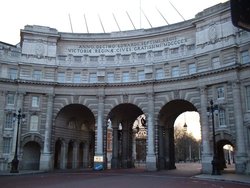
The approach road to the palace, known as The Mall, forms part of the state ceremonial route to the palace, beginning at Admiralty Arch. This route, devised as a memorial to Queen Victoria, is used by the cavalcades and motorcades of all visiting heads of state, and by the Royal Family on state occasions such as the annual State Opening of Parliament. On these occasions the processions pass through Admiralty Arch and into the Mall, which has been closed for the occasion, often bringing traffic chaos to other parts of London.
At the rear of the palace is the large park-like Buckingham Palace Gardens, the largest private gardens in London. The landscape design was by Capability Brown, but the gardens were redesigned at the time of the palace rebuilding by William Townsend Ailton of Kew Gardens and John Nash. The great man-made lake was completed in 1828 and is supplied with water by the Serpentine lake in Hyde Park. Like the palace itself, the gardens are rich in works of art. One of the most notable is the Waterloo Vase, the great urn commissioned by Napoleon to commemorate his anticipated victories, which in 1815 was presented unfinished to George IV by the Duke of Tuscany. The king had the vase completed by the sculptor Richard Westmacott with the intention that it be the focal point of the new Waterloo chamber at Windsor Castle. But weighing 15 tons and at 15ft high, no floor could bear the weight, and it was presented to the National Gallery. The Gallery finally returned the white elephant to the sovereign in 1906. Edward VII then solved the problem by placing the vase outside in the garden where it now remains. Also in the gardens is a small summerhouse attributed to William Kent circa 1740.
Adjacent to the palace are the Royal Mews, also designed by Nash, where the royal carriages, including the coronation or state coach, are housed. This rococo gilt coach, designed by Sir William Chambers in 1760, has painted panels by G. B. Cipriani. It was first used for the State Opening of Parliament by George III in 1762. It is used by the monarch only for coronations or momentous jubilee celebrations. Also housed in the mews are the many carriage horses used in the royal ceremonial processions which take place in London throughout the year.
The Palace today
Today, Buckingham Palace is not only the home of the Queen and Prince Philip but also the London residence of Duke of York and the Earl and Countess of Wessex. The palace also houses the office of the monarchy and its associated functions. Compared to other British royal palaces and castles, Buckingham Palace is comparatively new, yet the words "Buckingham Palace" have come to symbolise the British monarchy. At the end of both World War I and World War II vast crowds spontaneously gathered at the palace, as they had at the end of the Boer War. Although the popularity of the monarchy is reported to be in decline, an estimated crowd of one million people gathered in London, many in front of the palace, to see the Queen on her Golden Jubilee in June 2002. Buckingham Palace seems destined to remain a functioning royal palace for the foreseeable future.
See also
- List of Palaces
- including the other past and present London palaces:
- Kensington Palace
- Palace of Placentia
- Savoy Palace
- Palace of Westminster – Royal residence from 1049 until 1530
- Palace of Whitehall – Royal residence from 1530 until 1698
- St. James's Palace – Royal residence from 1702 until 1837
- UK topics
Foot notes
1: Thomas Blaikie. You look awfully like the Queen, Wit and Wisdom from the House of Windsor. 2002. Harper Collins. ISBN 0007148747
External links
- Buckingham Palace (http://www.royal.gov.uk/output/page555.asp), official site
- One's home is a dump (http://www.thisislondon.com/londoncuts/articles/17410992) (22 March 2005)
References
- Harris, John; de Bellaigue, Geoffrey; & Miller, Oliver (1968). Buckingham Palace. New York: Viking Press. Library of Congress catalogue card no: 62-23206.
- Headley Olwen (1970) Buckingham Palace. Garrod & Lofthouse Ltd. ISBN 85372 086 X
- Robinson, John Martin (1999). Buckingham Palace. Published by The Royal Collection, St. James's Palace, London ISBN 1902163362.
- Williams, Neville (1971). Royal Homes. Lutterworth Press. ISBN 0718808037.
- Woodham-Smith, Cecil (1973). Queen Victoria (vol 1) Hamish Hamilton Ltd.da:Buckingham Palace
de:Buckingham Palace eo:Palaco Buckingham fr:Buckingham Palace he:ארמון בקינגהאם nl:Buckingham Palace no:Buckingham Palace ja:バッキンガム宮殿 sl:Buckinghamska palača fi:Buckinghamin palatsi pt:Palácio de Buckingham sv:Buckingham Palace ta:பக்கிங்ஹாம் அரண்மனை zh-cn:白金汉宫

